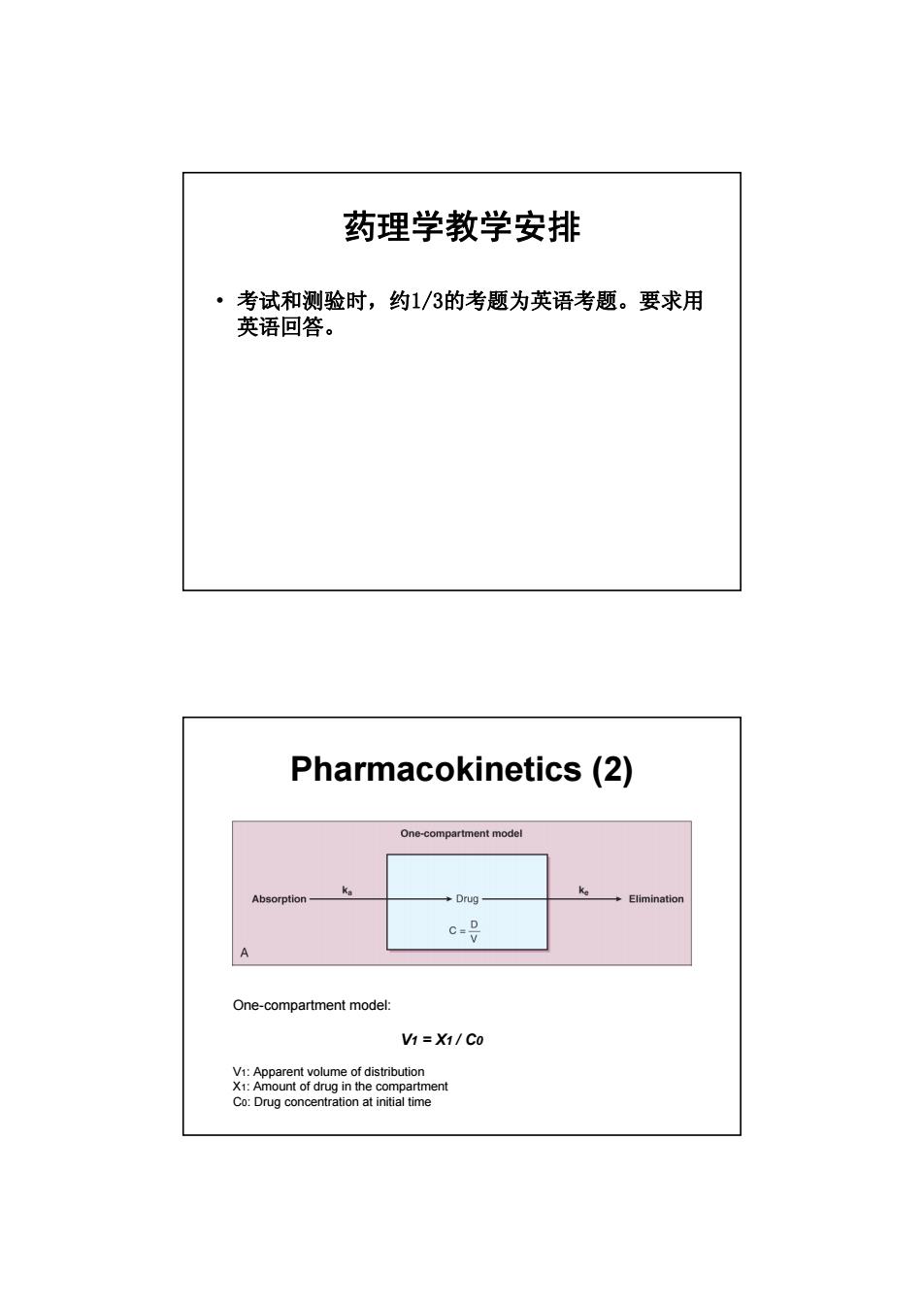
药理学教学安排 ·考试和测验时,约1/3的考题为英语考题。要求用 英语回答。 Pharmacokinetics(2) One-compartment model Absorption- Drug- Elimination c-v One-compartment model: V1=X1/Co V1:Apparent volume of distribution X1:Amount of drug in the compartment Co:Drug concentration at initial time
药理学教学安排 • 考试和测验时,约1/3的考题为英语考题。要求用 英语回答。 Pharmacokinetics (2) One-compartment model: V1 = X1 / C0 V1: Apparent volume of distribution X1: Amount of drug in the compartment C0: Drug concentration at initial time
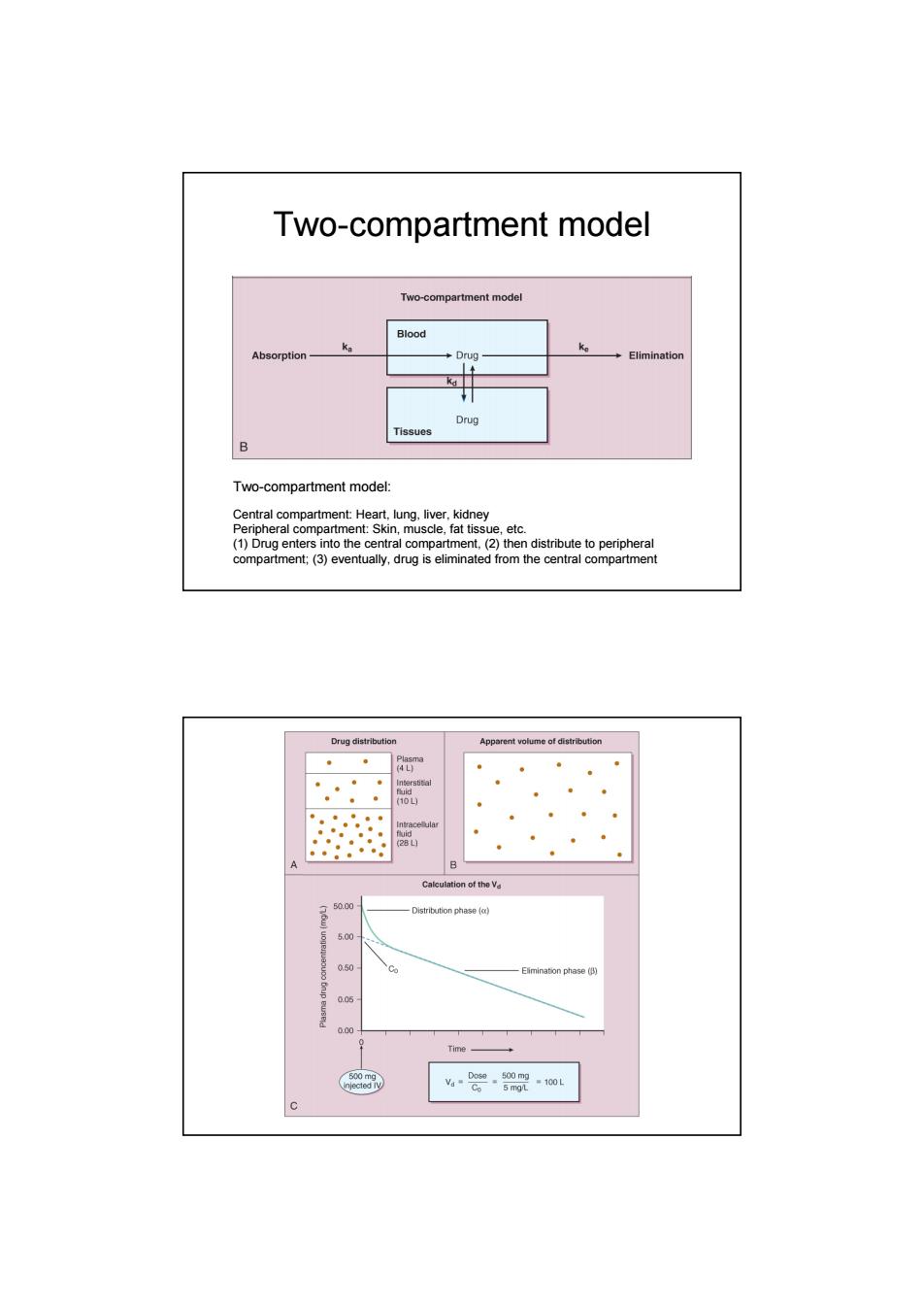
Two-compartment model Two-compartment model Blood Absorption- Drug Elimination Drug Tissues Two-compartment model: Central compartment:Heart,lung,liver,kidney Peripheral compartment:Skin,muscle,fat tissue,etc. (1)Drug enters into the central compartment,(2)then distribute to peripheral compartment;(3)eventually,drug is eliminated from the central compartment Drug distribution Apparent volume of distribution Plasma 4L) (10) A B Calculation of the Va (bw 50.00 Distribution phase(侧 5.00 -CP Elimination phase() 0.00 Time- =100
Two-compartment model Two-compartment model: Central compartment: Heart, lung, liver, kidney Peripheral compartment: Skin, muscle, fat tissue, etc. (1) Drug enters into the central compartment, (2) then distribute to peripheral compartment; (3) eventually, drug is eliminated from the central compartment
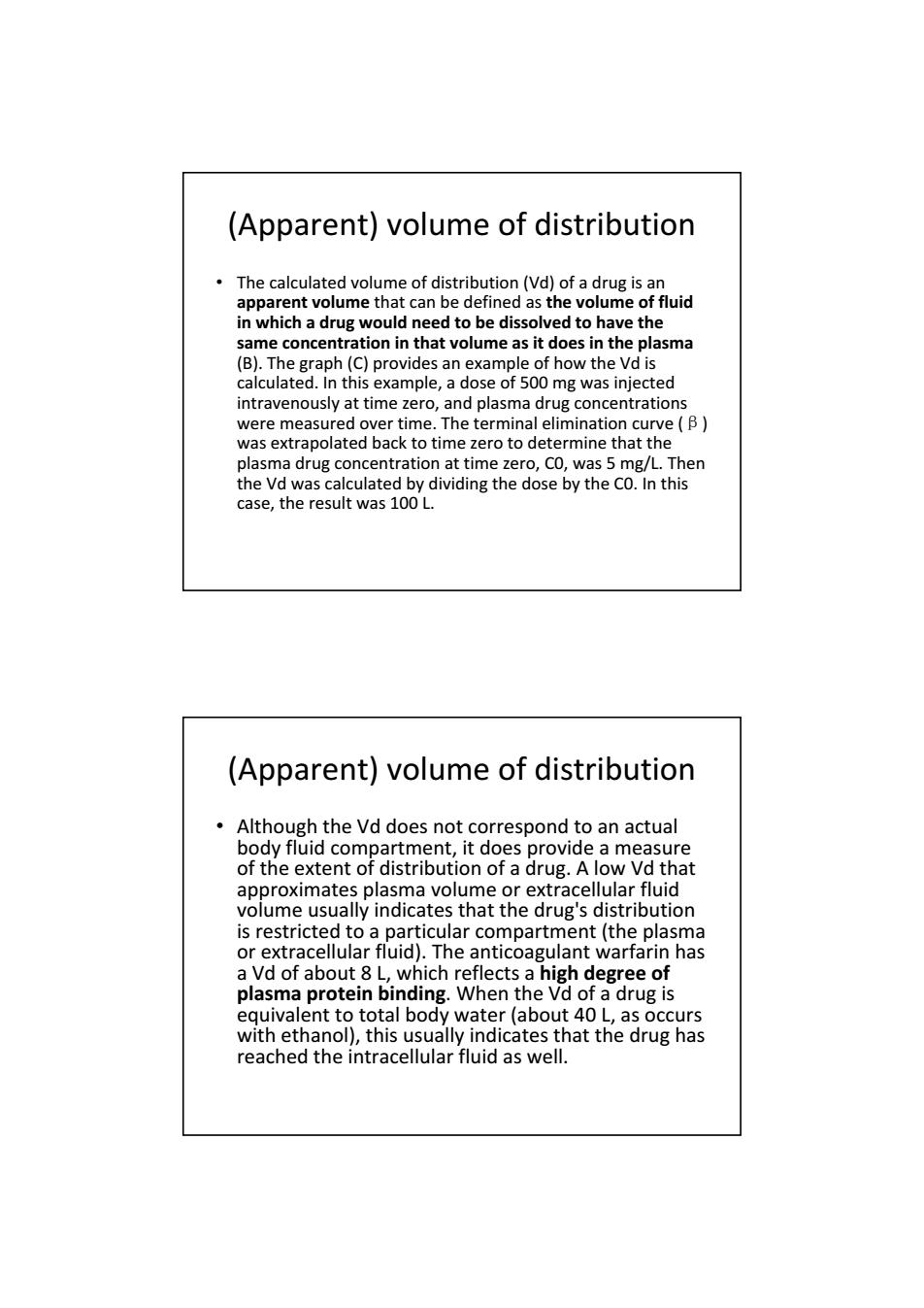
(Apparent)volume of distribution The calculated volume of distribution(Vd)of a drug is an apparent volume that can be defined as the volume of fluid in which a drug would need to be dissolved to have the same concentration in that volume as it does in the plasma (B).The graph(C)provides an example of how the Vd is calculated.In this example,a dose of 500 mg was injected intravenously at time zero,and plasma drug concentrations were measured over time.The terminal elimination curve(B) was extrapolated back to time zero to determine that the plasma drug concentration at time zero,Co,was 5 mg/L.Then the Vd was calculated by dividing the dose by the Co.In this case,the result was 100 L. (Apparent)volume of distribution Although the Vd does not correspond to an actual body fluid compartment,it does provide a measure of the extent of distribution of a drug.A low Vd that approximates plasma volume or extracellular fluid volume usually indicates that the drug's distribution is restricted to a particular compartment(the plasma or extracellular fluid).The anticoagulant warfarin has a Vd of about 8 L,which reflects a high degree of plasma protein binding.When the Vd of a drug is equivalent to total body water(about 40 L,as occurs with ethanol),this usually indicates that the drug has reached the intracellular fluid as well
• The calculated volume of distribution (Vd) of a drug is an apparent volume that can be defined as the volume of fluid in which a drug would need to be dissolved to have the same concentration in that volume as it does in the plasma (B). The graph (C) provides an example of how the Vd is calculated. In this example, a dose of 500 mg was injected intravenously at time zero, and plasma drug concentrations were measured over time. The terminal elimination curve (β) was extrapolated back to time zero to determine that the plasma drug concentration at time zero, C0, was 5 mg/L. Then the Vd was calculated by dividing the dose by the C0. In this case, the result was 100 L. (Apparent) volume of distribution • Although the Vd does not correspond to an actual body fluid compartment, it does provide a measure of the extent of distribution of a drug. A low Vd that approximates plasma volume or extracellular fluid volume usually indicates that the drug's distribution is restricted to a particular compartment (the plasma or extracellular fluid). The anticoagulant warfarin has a Vd of about 8 L, which reflects a high degree of plasma protein binding. When the Vd of a drug is equivalent to total body water (about 40 L, as occurs with ethanol), this usually indicates that the drug has reached the intracellular fluid as well. (Apparent) volume of distribution
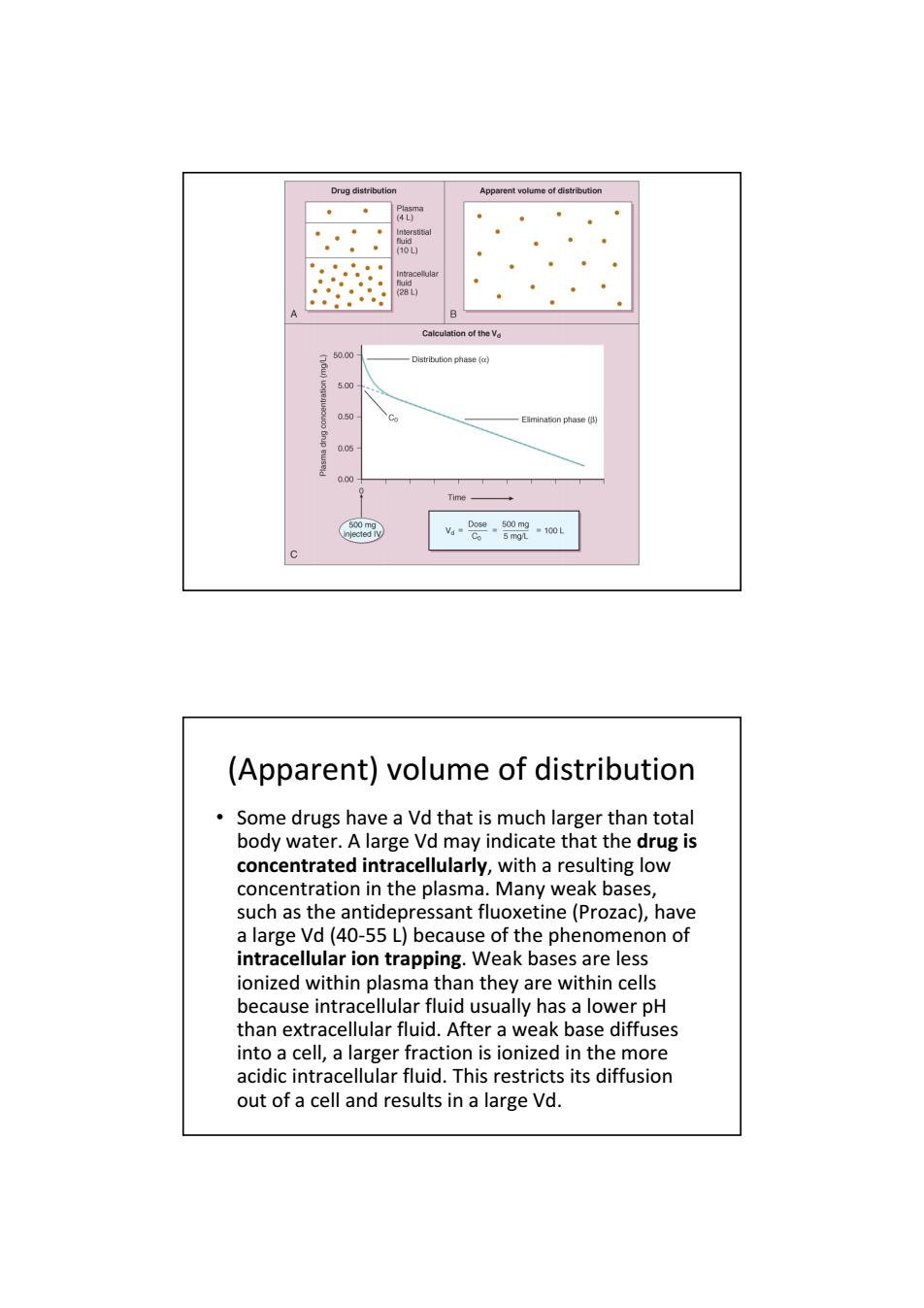
Drug distribution Apparent volume of distribution (10L) B Calculation of the Va 50.00 .6 Distribution phase(回) 5.00 0.50 -C Elimination phase() 0.05 0.00 Time- =100L (Apparent)volume of distribution Some drugs have a Vd that is much larger than total body water.A large Vd may indicate that the drug is concentrated intracellularly,with a resulting low concentration in the plasma.Many weak bases, such as the antidepressant fluoxetine (Prozac),have a large Vd(40-55 L)because of the phenomenon of intracellular ion trapping.Weak bases are less ionized within plasma than they are within cells because intracellular fluid usually has a lower pH than extracellular fluid.After a weak base diffuses into a cell,a larger fraction is ionized in the more acidic intracellular fluid.This restricts its diffusion out of a cell and results in a large Vd
• Some drugs have a Vd that is much larger than total body water. A large Vd may indicate that the drug is concentrated intracellularly, with a resulting low concentration in the plasma. Many weak bases, such as the antidepressant fluoxetine (Prozac), have a large Vd (40‐55 L) because of the phenomenon of intracellular ion trapping. Weak bases are less ionized within plasma than they are within cells because intracellular fluid usually has a lower pH than extracellular fluid. After a weak base diffuses into a cell, a larger fraction is ionized in the more acidic intracellular fluid. This restricts its diffusion out of a cell and results in a large Vd. (Apparent) volume of distribution
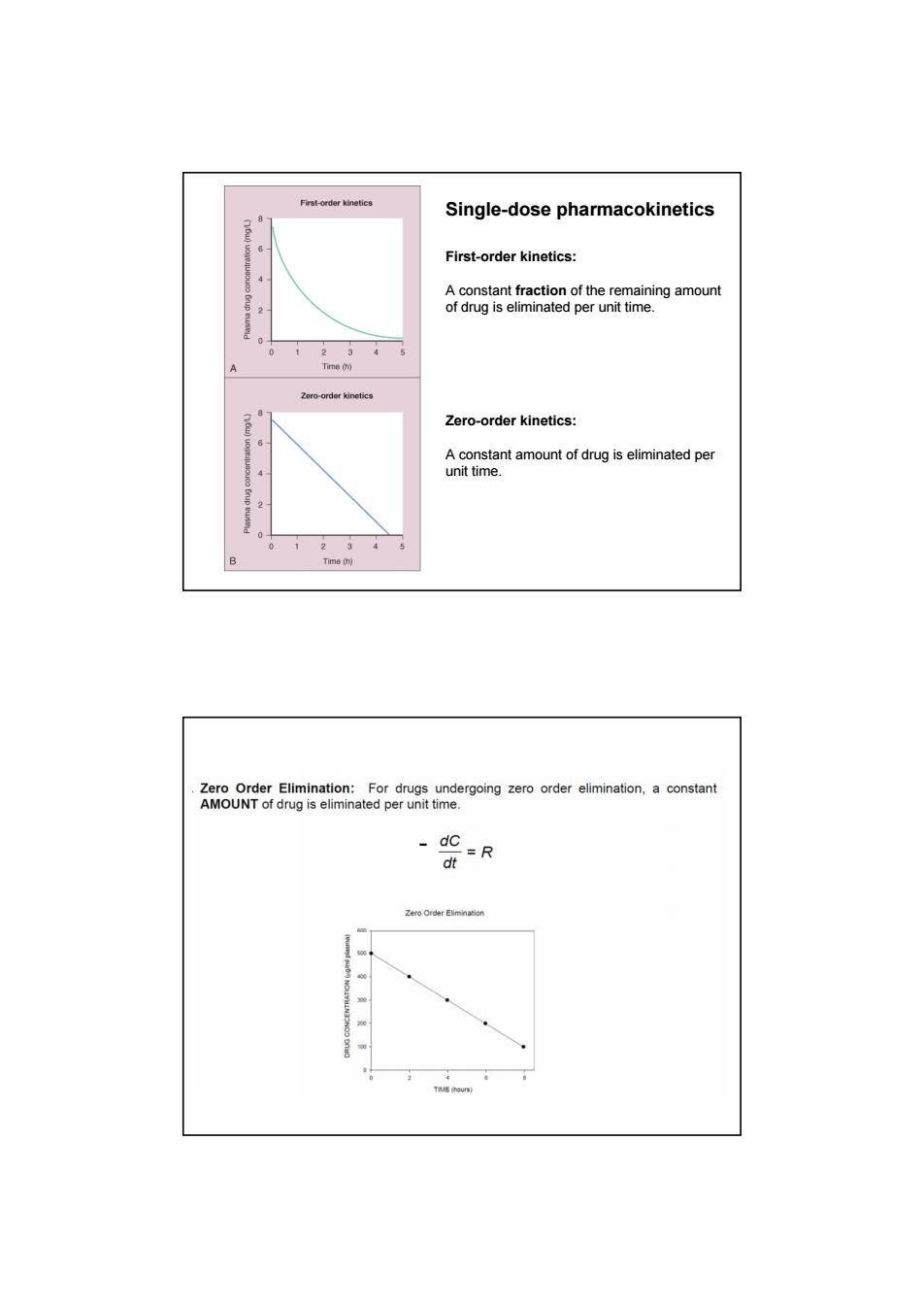
First-order kinetics Single-dose pharmacokinetics 8 8 First-order kinetics: 4 A constant fraction of the remaining amount 2 of drug is eliminated per unit time. 0 0 1 23 4 A Time (h) Zero-order kinetics Zero-order kinetics: A constant amount of drug is eliminated per 4 unit time. 2 0 0 1 2 4 Time (h) Zero Order Elimination:For drugs undergoing zero order elimination,a constant AMOUNT of drug is eliminated per unit time. dc =R dt Zero Order Elimination
First-order kinetics: A constant fraction of the remaining amount of drug is eliminated per unit time. Single-dose pharmacokinetics Zero-order kinetics: A constant amount of drug is eliminated per unit time
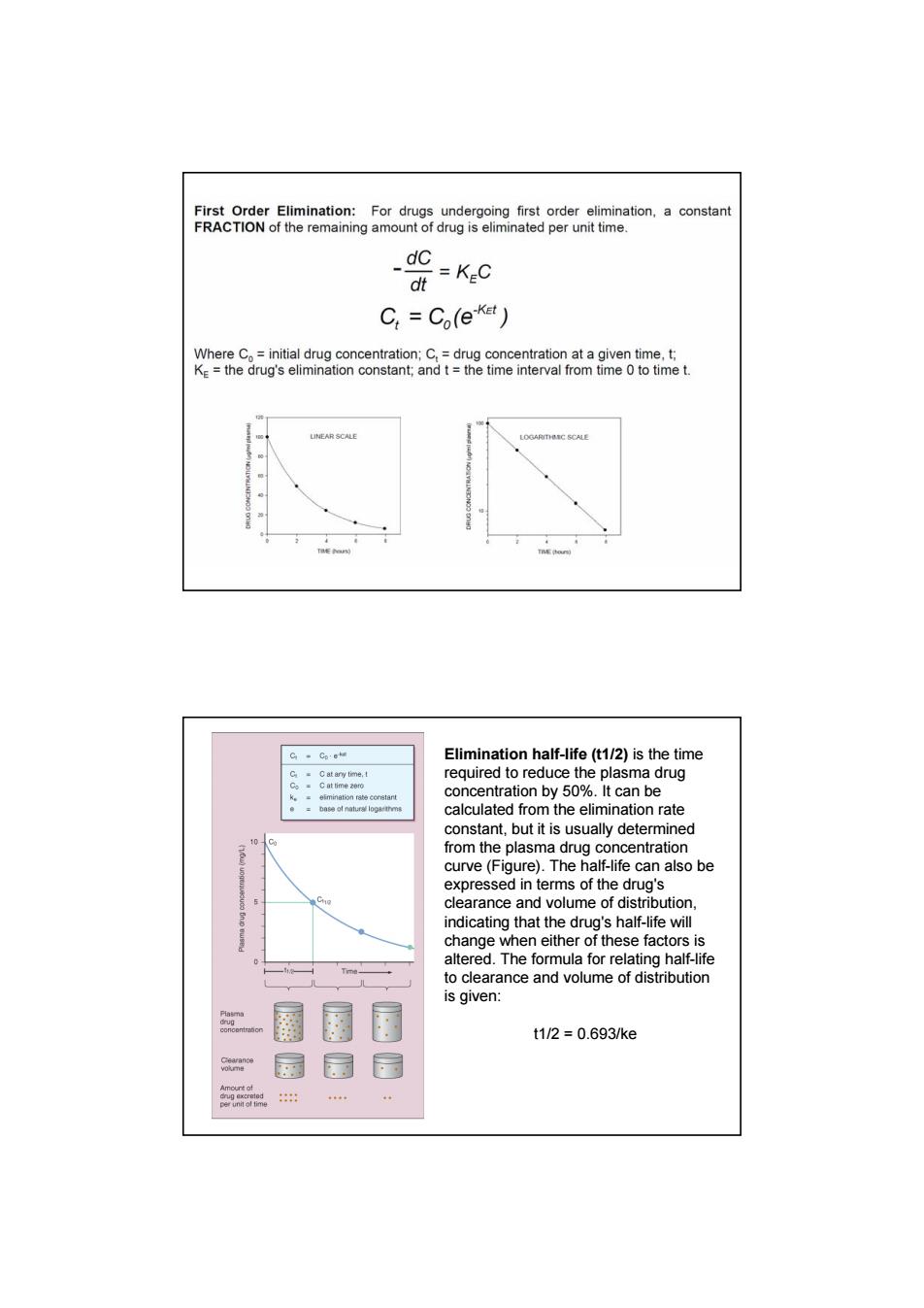
First Order Elimination:For drugs undergoing first order elimination,a constant FRACTION of the remaining amount of drug is eliminated per unit time dC dt =KC C=Co(erket) Where C.initial drug concentration;C,drug concentration at a given time,t; K=the drug's elimination constant;and t=the time interval from time 0 to time t. LUME人R SCALE LOGARITHMC SCALE Elimination half-life(t1/2)is the time C C at any time,t required to reduce the plasma drug C。=Cat time zero eimination rate constant concentration by 50%.It can be calculated from the elimination rate constant,but it is usually determined from the plasma drug concentration curve (Figure).The half-life can also be expressed in terms of the drug's clearance and volume of distribution. indicating that the drug's half-life will change when either of these factors is altered.The formula for relating half-life to clearance and volume of distribution is given: t1/2=0.693/ke
Elimination half-life (t1/2) is the time required to reduce the plasma drug concentration by 50%. It can be calculated from the elimination rate constant, but it is usually determined from the plasma drug concentration curve (Figure). The half-life can also be expressed in terms of the drug's clearance and volume of distribution, indicating that the drug's half-life will change when either of these factors is altered. The formula for relating half-life to clearance and volume of distribution is given: t1/2 = 0.693/ke
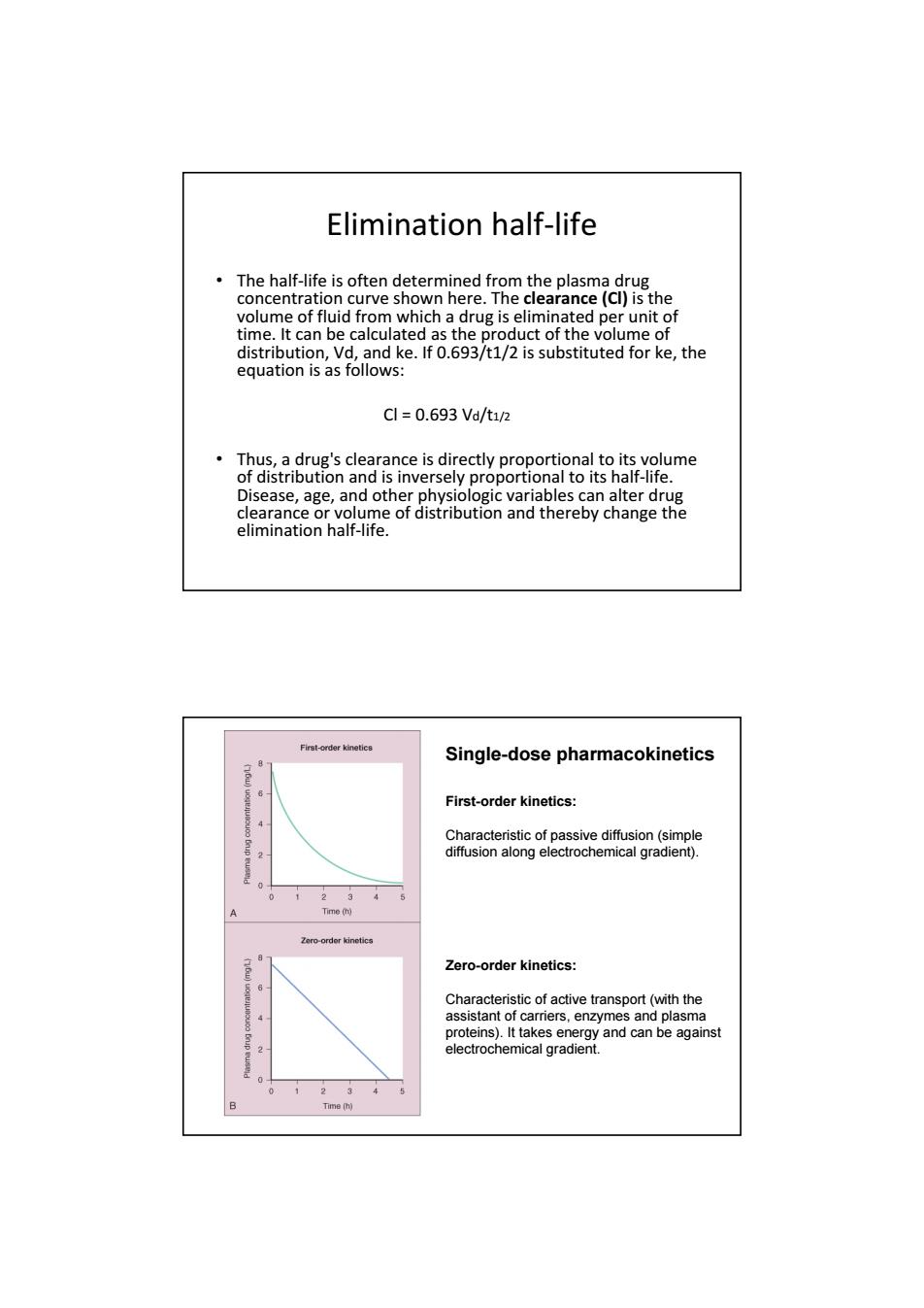
Elimination half-life The half-life is often determined from the plasma drug concentration curve shown here.The clearance(Cl)is the volume of fluid from which a drug is eliminated per unit of time.It can be calculated as the product of the volume of distribution,Vd,and ke.If 0.693/t1/2 is substituted for ke,the equation is as follows: Cl=0.693Vd/t12 Thus,a drug's clearance is directly proportional to its volume of distribution and is inversely proportional to its half-life. Disease,age,and other physiologic variables can alter drug clearance or volume of distribution and thereby change the elimination half-life. First-order kinetics Single-dose pharmacokinetics 8 First-order kinetics: Characteristic of passive diffusion(simple 2- diffusion along electrochemical gradient). 2 3 A Time (h) Zero-order kinetics Zero-order kinetics: Characteristic of active transport(with the 4 assistant of carriers,enzymes and plasma proteins).It takes energy and can be against 2 electrochemical gradient. 0 0 2 3 Time (h)
Elimination half‐life • The half‐life is often determined from the plasma drug concentration curve shown here. The clearance (Cl) is the volume of fluid from which a drug is eliminated per unit of time. It can be calculated as the product of the volume of distribution, Vd, and ke. If 0.693/t1/2 is substituted for ke, the equation is as follows: Cl = 0.693 Vd/t1/2 • Thus, a drug's clearance is directly proportional to its volume of distribution and is inversely proportional to its half‐life. Disease, age, and other physiologic variables can alter drug clearance or volume of distribution and thereby change the elimination half‐life. First-order kinetics: Characteristic of passive diffusion (simple diffusion along electrochemical gradient). Single-dose pharmacokinetics Zero-order kinetics: Characteristic of active transport (with the assistant of carriers, enzymes and plasma proteins). It takes energy and can be against electrochemical gradient
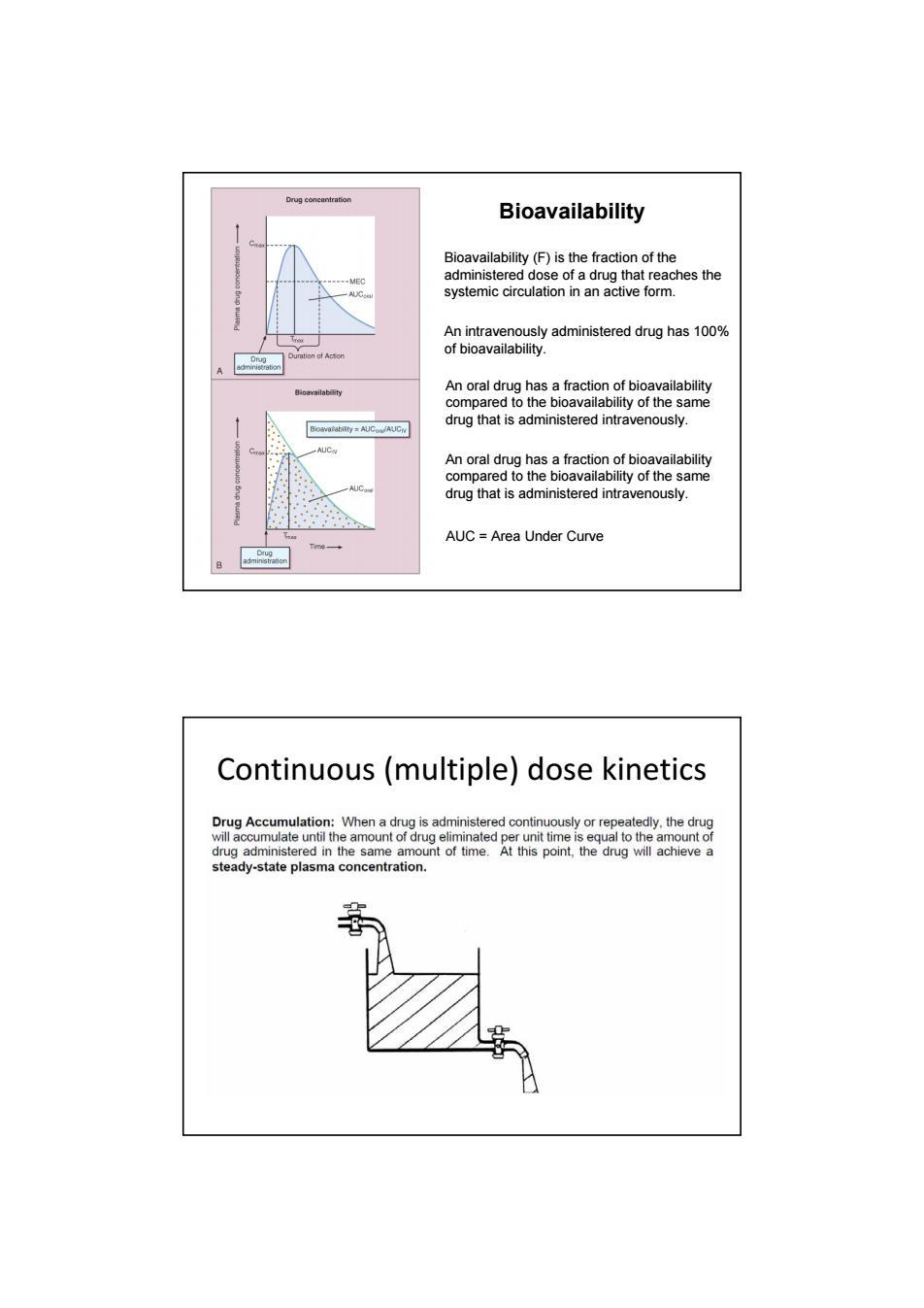
Bioavailability Bioavailability(F)is the fraction of the ME administered dose of a drug that reaches the systemic circulation in an active form An intravenously administered drug has 100% of bioavailability. A Bioavailabiity An oral drug has a fraction of bioavailability compared to the bioavailability of the same drug that is administered intravenously. An oral drug has a fraction of bioavailability compared to the bioavailability of the same drug that is administered intravenously. AUC Area Under Curve Te一 Continuous(multiple)dose kinetics Drug Accumulation:When a drug is administered continuously or repeatedly.the drug will accumulate until the amount of drug eliminated per unit time is equal to the amount of drug administered in the same amount of time.At this point,the drug will achieve a steady-state plasma concentration
Bioavailability Bioavailability (F) is the fraction of the administered dose of a drug that reaches the systemic circulation in an active form. An intravenously administered drug has 100% of bioavailability. An oral drug has a fraction of bioavailability compared to the bioavailability of the same drug that is administered intravenously. An oral drug has a fraction of bioavailability compared to the bioavailability of the same drug that is administered intravenously. AUC = Area Under Curve Continuous (multiple) dose kinetics
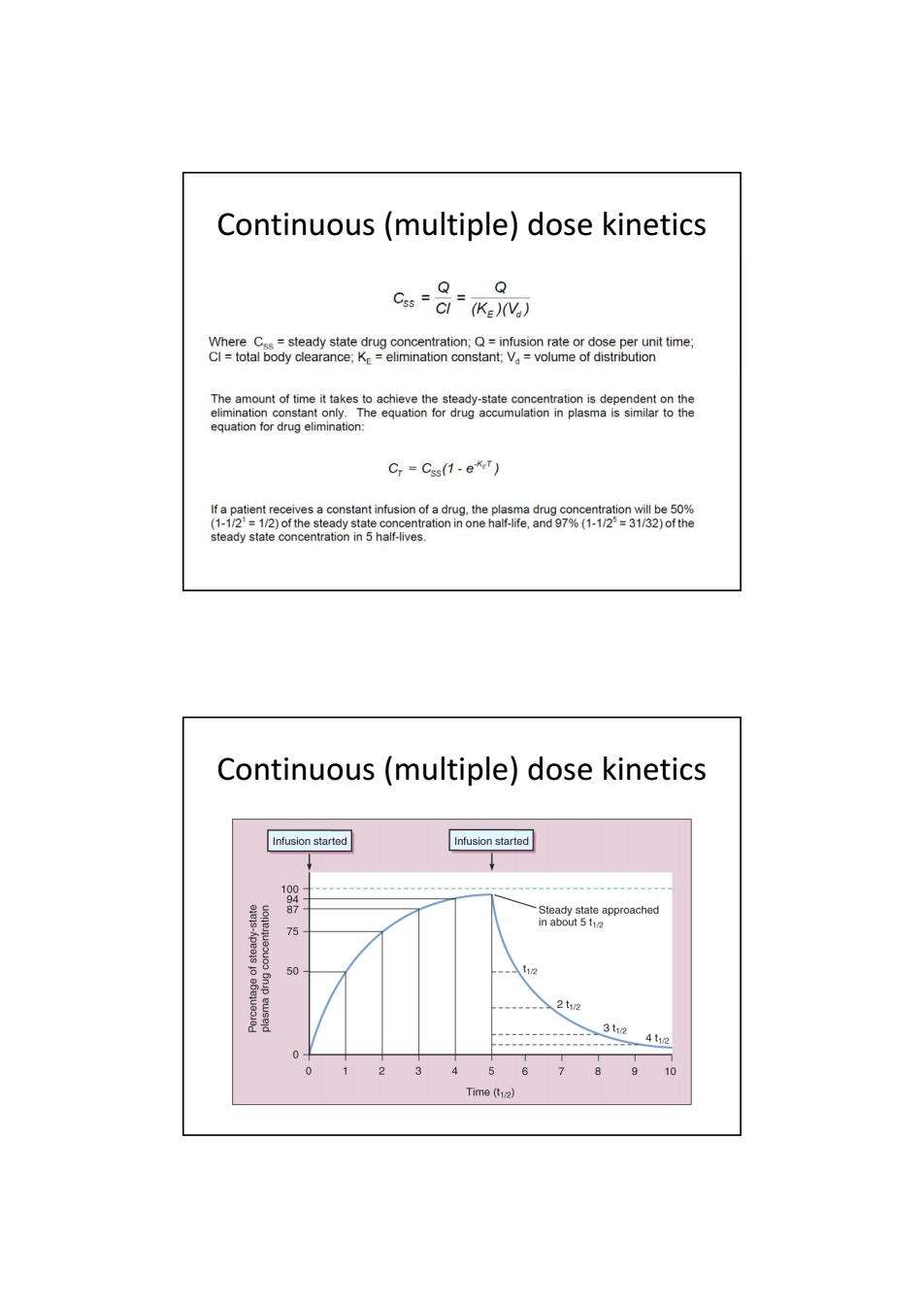
Continuous(multiple)dose kinetics Q CI(KE)(Va) Where Cs=steady state drug concentration;Q=infusion rate or dose per unit time; CI=total body clearance:K=elimination constant:V=volume of distribution The amount of time it takes to achieve the steady-state concentration is dependent on the elimination constant only.The equation for drug accumulation in plasma is similar to the equation for drug elimination: Cr =Css(1-ekeT) If a patient receives a constant infusion of a drug,the plasma drug concentration will be50% (1-1/2'=1/2)of the steady state concentration in one half-life,and 97%(1-1/2=31/32)of the steady state concentration in 5 half-lives. Continuous(multiple)dose kinetics Infusion started Infusion started Steady state approached 7 in about 5 t12 0 2t2 4t12 0 0 6 78 9 10 Time (t1/2)
Continuous (multiple) dose kinetics Continuous (multiple) dose kinetics
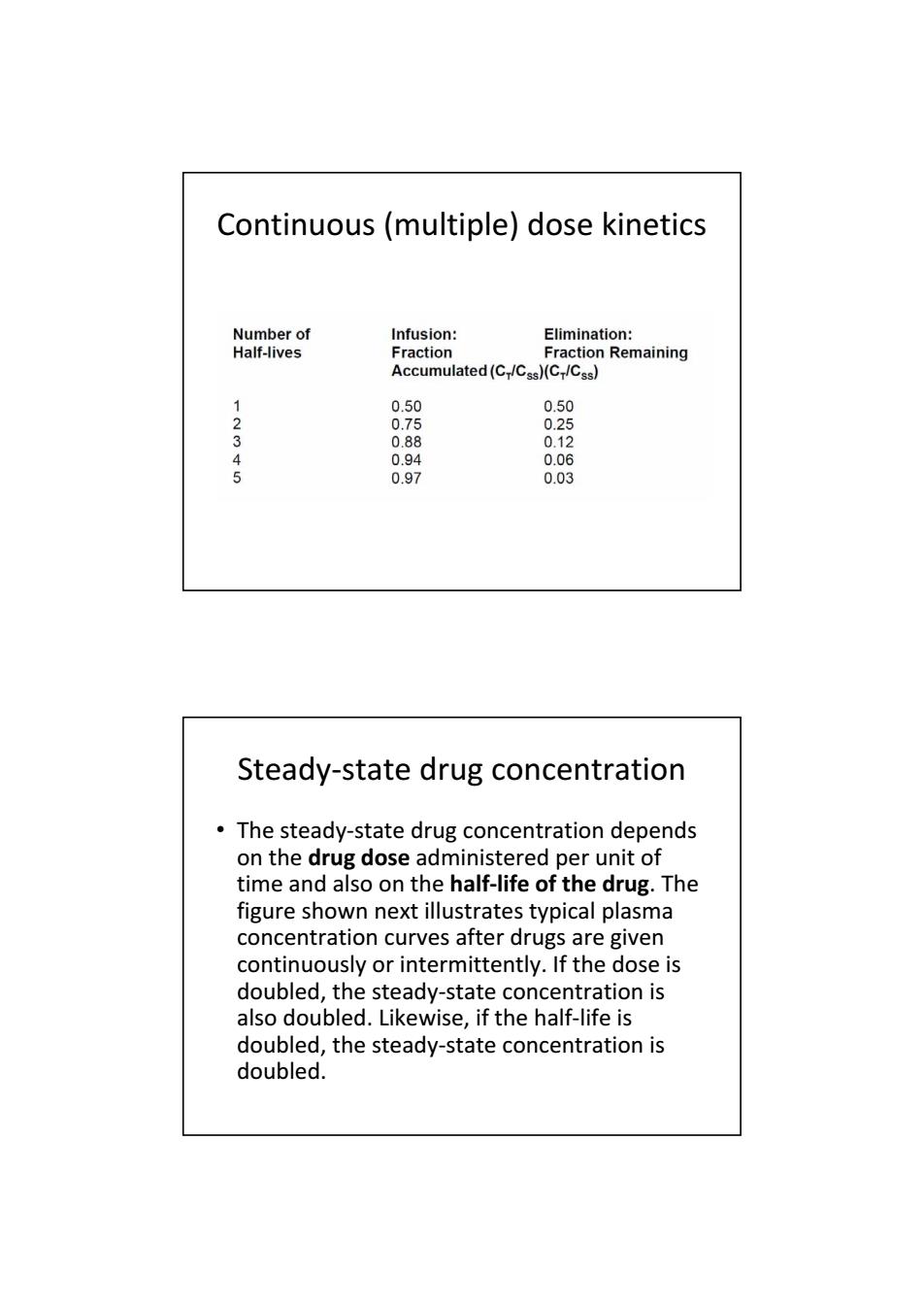
Continuous(multiple)dose kinetics Number of Infusion: Elimination: Half-lives Fraction Fraction Remaining Accumulated(C/Css)(C/Css) 1 0.50 0.50 2345 0.75 0.25 0.88 0.12 0.94 0.06 0.97 0.03 Steady-state drug concentration The steady-state drug concentration depends on the drug dose administered per unit of time and also on the half-life of the drug.The figure shown next illustrates typical plasma concentration curves after drugs are given continuously or intermittently.If the dose is doubled,the steady-state concentration is also doubled.Likewise,if the half-life is doubled,the steady-state concentration is doubled
Continuous (multiple) dose kinetics • The steady‐state drug concentration depends on the drug dose administered per unit of time and also on the half‐life of the drug. The figure shown next illustrates typical plasma concentration curves after drugs are given continuously or intermittently. If the dose is doubled, the steady‐state concentration is also doubled. Likewise, if the half‐life is doubled, the steady‐state concentration is doubled. Steady‐state drug concentration